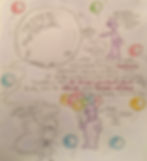
(Testing x Remediation/Numerical Measurement) - Learning = Inflation
Sometimes when I read, I sketch--not to be cute, but to figure out where I fit in. Where have I made these mistakes? Where have I fallen into the trap? Where have I been swayed by external expectations. And I guess this sketch (inspired by The Testing Charade by Daniel Koretz) emerged as I kept thinking about the low-scoring students we try to help or remediate. The image of patching a leaky balloon just kind of emerged as I sketched what troubled me.
We say that we are helping students...now, I'm not so sure. At the very least I am questioning how helpful remediation is in the long run or in the trajectory of student learning. Maybe remediation isn't about learning. Maybe it is just about testing.
In my imagination, I see more, smaller, balloons with "skill" written on them than what I drew here. I see a whole room of listless, ignored balloons. Some on the floor. Some barely floating a few inches from the ground. I find myself thinking about everything I do not emphasize today and how my actions may, indeed, be helping students raise their scores (a.k.a inflating the scores).
But am I helping students learn anything that they can use (other than on a test)? Maybe. Maybe not. Although. at least on this page, the thinking in my sketch may be more certain of the truth than the thinking in my words.

